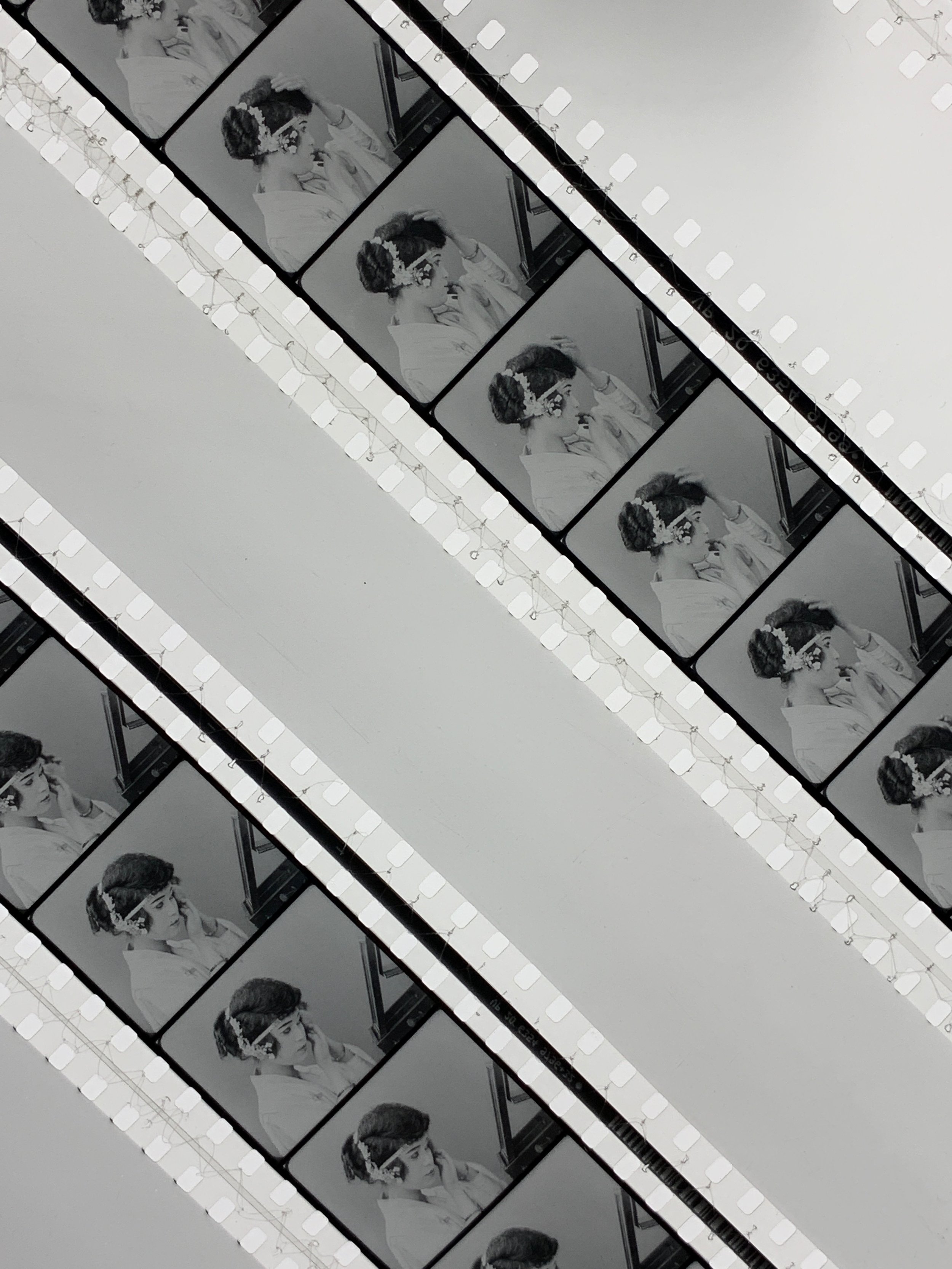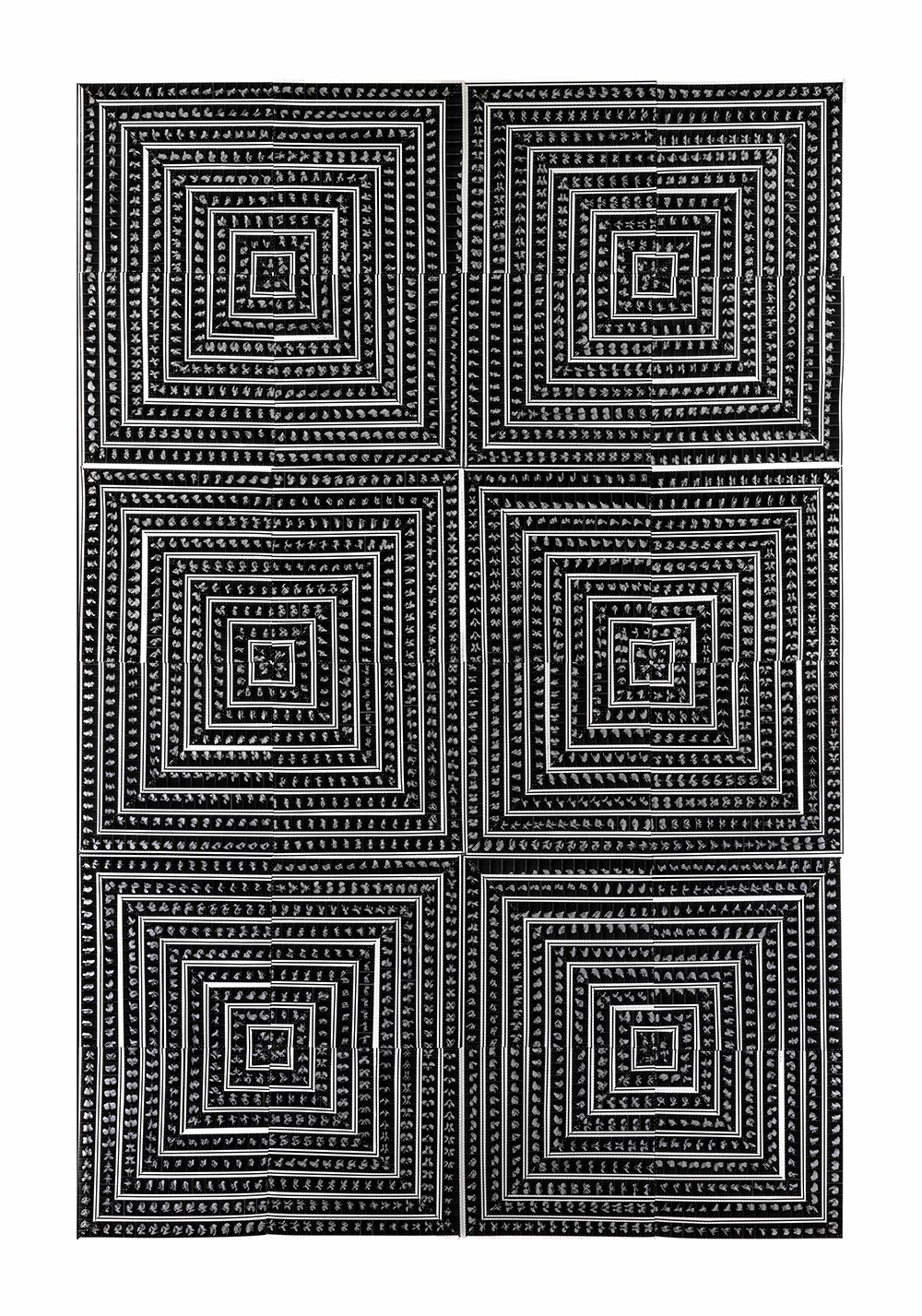













This series utilizes film footage created by women cinema pioneers whose work from the late 1800s - early 1900s is woefully under-recognized. I re-printed footage from their films, sourced from archives around the world, onto black and white 35 mm film stock, and then cut and sewed the footage into configurations based on quilt motifs.
Photo: Ian Byers-Gamber.
Exhibited at Hauser & Wirth Los Angeles; Skirball Cultural Center, Los Angeles; Los Angeles Municipal Art Gallery; Len Lye Centre/Govett-Brewster Art Gallery, New Zealand, and the Walker Art Center, Minneapolis, MN, among others.

Film footage courtesy of Academy Film Library and Kino Lorber, Inc. Special thanks to Gregory Yee Mark.
Photo: Ana Venegas. Courtesy of the Los Angeles Municipal Art Gallery.
Marion E. Wong’s 1917 film The Curse of Quon Gwon: When the Far East Mingles With the West challenges the established narrative of American film industry history in which white men made the first movies and started or ran all of the first filmmaking companies. It was the only film Wong made through her own production company, based in Oakland, CA, and only fragments of the film remain. None of the surviving material includes intertitles. The film failed to find distribution because distributors didn’t think that white audiences would watch an Asian American movie that didn’t feature racist tropes.
For this film quilt, I chose to work with a one minute sequence from the film in which the bride is preparing her hair before a traditional Chinese tea ceremony, to take place before a wedding. There is an incredible shot in this sequence where the bride is beautifully framed looking into a mirror. In a poignant act of self-determination, the bride makes gestures to signal the way she wants her hair to look, and then that she wants to do her own hair. I took the cinematic framing of the actress’s face in the mirror as inspiration for the pattern in this quilt, in which there is a center square that radiates out. The center square replicates the mirror. I built out either side of the center square with the other shots from the sequence, in chronological order: first an establishing shot of the room, then the bride sitting down, then looking in the mirror, next having her hair brushed, then signaling she wants to do her own hair, then finishing her hair, and finally a cut back out to show the whole room.
I included footage that contains film lab notations about my print order, as well as footage that contains the image of the Kodak “LAD” lady, which is a photo of a white woman accompanied by color or grayscale bars that appears for a few frames in film leader. Starting in the 1920s, prior to the 1976 invention of the LAD system, a “China Girl” was similarly used as a reference guide to achieve consistent color balance and tonal density throughout a film print. Possibly named after porcelain (“china”) mannequins who may have stood in for live women at some point, China Girls were almost always young, conventionally attractive, white women, indicating the degree to which an idealized female body has been used in the movie industry, even at the level of the technological reproduction of the material.
Collection: Toledo Museum of Art, OH

Film footage courtesy of Academy Film Library and Kino Lorber, Inc. Special thanks to Gregory Yee Mark.
Collection: Toledo Museum of Art, OH

Film footage courtesy of EYE Filmmuseum, the Netherlands.
Photo: Ana Venegas. Courtesy of the Los Angeles Municipal Art Gallery.
Germaine Dulac’s 1927 film The Seashell and the Clergyman is an early avant- garde film and displays the kind of “experiment in rhythm” Dulac was most interested in. Dulac was a filmmaker, film theorist, and critic who pushed the boundaries of the medium. When the film premiered in Paris in 1928, it incited a misogynistic riot.
I chose a one minute sequence from the film in which the clergyman carefully measures liquid into beakers and then releases the beakers onto the ground, where they shatter. There are multiple interpretations of the broken glass in this film, one of them being the breaking of cinematic conventions. The shattered glass also symbolizes the clergyman’s frustration with not being able to capture the object of his obsession - a woman. I sewed this footage into a log cabin square with black and white blocks that are arranged into diagonals of light and dark footage. The light diagonals symbolize pieces of shattered glass.

Film footage courtesy of Gaumont Pathé Archives.
I began this series with footage shot in 1897 by Alice Guy-Blaché, who is known as the first female filmmaker in the world, and who was a key figure in the invention of narrative cinema.
I wanted to work with Guy-Blaché’s 1897 film of Mrs. Bob Walter performing Walter’s version of the “Serpentine Dance,” invented and made popular by Loie Fuller, in order to address the double erasure the film represents. Not only has Alice Guy-Blaché been under-recognized for her work, but because Loie Fuller couldn’t copyright her dance, she was heavily imitated. This footage is of Mrs. Bob Walter performing Fuller’s Serpentine Dance.
When creating a film quilt from this footage, I chose a pattern that could mimic the kind of circular movement Mrs. Bob Walter performs for the camera. The seams in the quilt cut off various parts of the dancer’s body, creating new forms that are in keeping with interpretations of the billowing dress, which can resemble flowers or insects. Loie Fuller combined her choreography with projected, colored light onto her silk costumes, which connects to the transparency and backlighting of this piece, in which film becomes fabric.
Collection: Walker Art Center, Minneapolis, MN

Film footage courtesy of Gaumont Pathé Archives.
Photo: Ana Venegas. Courtesy of the Los Angeles Municipal Art Gallery.

Lotte Reiniger was a pioneer of silhouette animation. Her 1926 animation The Adventures of Prince Achmed is the oldest surviving animated feature film. Her work was sometimes dismissed by film critics for offering escapism via classic fairy tales. I chose her hand-cut animation Cinderella (1922) because I was drawn to how she drew agency from handcraft, by using a pair of scissors as a narrative device and as a tool to modify the shape of the film frame itself. As her intertitles state, "What Cinderella suffered from the two sisters and her stepmother, how she grew into a fairy-princess here is seen, told by a pair of scissors on a screen." First, Reiniger shows a pair of hands and scissors creating the figure of Cinderella from paper. Then, as the film progresses, the self-proclaimed "snip" of the scissors propels narrative events forward. Wielded by Reiniger, the scissors are the maker of the tale.
Reiniger worked with her hand cut figures on a back-lit animation table, which is similar to my working method. For her Cinderella, she used scissors to change the shape of the film frame, which constantly mutates in the movie, from ovals and rectangles to the shape of a clock or a window pane.
For the large film quilt I made from this film, I used a pattern called antique lace, in reference to the lace-like matte around the intertitles. There are circles, triangles, and diamonds in the pattern, referencing the way Reiniger transformed the rectangle of the film frame.
Photo: Ian Byers-Gamber.

Photo: Ian Byers-Gamber.

Photo: Ian Byers-Gamber.

Photo: Ian Byers-Gamber.

Photo: Ian Byers-Gamber.

Photo: Ian Byers-Gamber.